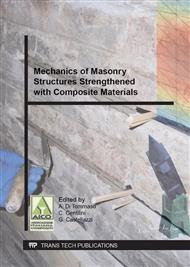[1]
M. R. Valluzzi, D. V. Oliveira, A. Caratelli, G. Castori, M. Corradi, G. de Felice, E. Garbin, D. Garcia, L. Garmendia, E. Grande, U. Ianniruberto, A. Kwiecień, M. Leone, G. P. Lignola, P. B. Lourenço, M. Malena, F. Micelli, M. Panizza, C. G. Papanicolaou, A. Prota, E. Sacco, T. C. Triantafillou, A. Viskovic, B. Zając, G. Zuccarino. Round Robin Test For Composite-To-Brick Shear Bond Characterization. Materials and Structures RILEM, 45, 1761-1791, (2012).
DOI: 10.1617/s11527-012-9883-5
Google Scholar
[2]
P. Carrara, F. Freddi., Statistical assessment of a design formula for the debonding resistance of FRP reinforcements externally glued on masonry units, in press on Comp. Part B, (2014).
DOI: 10.1016/j.compositesb.2014.04.032
Google Scholar
[3]
C. Carloni, K. Subramaniam, FRP-Masonry Debonding: Numerical and Experimental Study of the Role of Mortar Joints, J. Compos. Constr., 16(5), 581–589. (2012).
DOI: 10.1061/(asce)cc.1943-5614.0000282
Google Scholar
[4]
B. Ghiassi, D. V. Oliveira, P.B. Lourenço, G. Marcari, Numerical study of the role of mortar joints in the bond behavior of FRP-strengthened masonry, Comp. Part B, 46, 21-30, (2013).
DOI: 10.1016/j.compositesb.2012.10.017
Google Scholar
[5]
B. Ferracuti, M. Savoia, and C. Mazzotti, A numerical model for FRP–concrete delamination, Composites Part B: Engineering, 37, 356–364, (2006).
DOI: 10.1016/j.compositesb.2005.08.002
Google Scholar
[6]
K. Benzarti, F. Freddi, M. Frémond, A damage model to predict the durability of bonded assemblies. Part I: Debonding behavior of FRP strengthened concrete structures, Construction and Building Materials, 25, 547-555, (2011).
DOI: 10.1016/j.conbuildmat.2009.10.018
Google Scholar
[7]
J. Toti, S. Marfia, E. Sacco. Coupled body-interface nonlocal damage model for FRP detachment. Comput. Methods Appl. Mech. Engrg. 260, 1–23, (2013).
DOI: 10.1016/j.cma.2013.03.010
Google Scholar
[8]
F. Freddi, E. Sacco, An interface damage model depending on the deformation of the adherent, submitted. (2014).
Google Scholar
[9]
G. Giambanco, G. Fileccia Scimeni, A. Spada, The interphase finite element, Computational Mechanics, 50, 353–366, (2012).
DOI: 10.1007/s00466-011-0664-8
Google Scholar
[10]
P. Carrara, D. Ferretti, and F. Freddi, Debonding behavior of ancient masonry elements strengthened with CFRP sheets, Compos Part B - Eng, 45(1) 800-810, (2013).
DOI: 10.1016/j.compositesb.2012.04.029
Google Scholar
[11]
CNR DT200 Guide for the design and construction of an externally bonded FRP system for strengthening existing structures. Italian National Research Council, Rome (2004/2013).
Google Scholar


